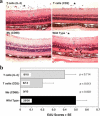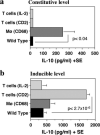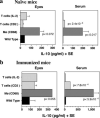Abrogation of anti-retinal autoimmunity in IL-10 transgenic mice due to reduced T cell priming and inhibition of disease effector mechanisms
- PMID: 18390724
- PMCID: PMC2442578
- DOI: 10.4049/jimmunol.180.8.5423
Abrogation of anti-retinal autoimmunity in IL-10 transgenic mice due to reduced T cell priming and inhibition of disease effector mechanisms
Abstract
Experimental autoimmune uveitis (EAU) induced by immunization of animals with retinal Ags is a model for human uveitis. The immunosuppressive cytokine IL-10 regulates EAU susceptibility and may be a factor in genetic resistance to EAU. To further elucidate the regulatory role of endogenous IL-10 in the mouse model of EAU, we examined transgenic (Tg) mice expressing IL-10 either in activated T cells (inducible) or in macrophages (constitutive). These IL-10-Tg mice and non-Tg wild-type controls were immunized with a uveitogenic regimen of the retinal Ag interphotoreceptor retinoid-binding protein. Constitutive expression of IL-10 in macrophages abrogated disease and reduced Ag-specific immunological responses. These mice had detectable levels of IL-10 in sera and in ocular extracts. In contrast, expression of IL-10 in activated T cells only partially protected from EAU and marginally reduced Ag-specific responses. All IL-10-Tg lines showed suppression of Ag-specific effector cytokines. APC from Tg mice constitutively expressing IL-10 in macrophages exhibited decreased ability to prime naive T cells, however, Ag presentation to already primed T cells was not compromised. Importantly, IL-10-Tg mice that received interphotoreceptor retinoid-binding protein-specific uveitogenic T cells from wild-type donors were protected from EAU. We suggest that constitutively produced endogenous IL-10 ameliorates the development of EAU by suppressing de novo priming of Ag-specific T cells and inhibiting the recruitment and/or function of inflammatory leukocytes, rather than by inhibiting local Ag presentation within the eye.
Figures








References
-
- Gritz DC, Wong IG. Incidence and prevalence of uveitis in Northern California; the Northern California Epidemiology of Uveitis Study. Ophthalmology. 2004;111:491–500. - PubMed
-
- Agarwal RK, Caspi RR. Rodent models of experimental autoimmune uveitis. Methods Mol. Med. 2004;102:395–419. - PubMed
-
- Gery I, Nussenblatt RB, Chan CC, Caspi RR. The Molecular Pathology of Autoimmune Diseases. Taylor and Francis; New York, NY: 2002. Autoimmune diseases of the eye. pp. 978–998.
-
- Caspi RR. Mechanisms underlying autoimmune uveitis. Drug Discov. Today: Dis. Mech. 2006;3:199–206.
-
- Tang J, Zhu W, Silver PB, Su SB, Chan CC, Caspi RR. Autoimmune uveitis elicited with antigen-pulsed dendritic cells has a distinct clinical signature and is driven by unique effector mechanisms: initial encounter with autoantigen defines disease phenotype. J. Immunol. 2007;178:5578–5587. - PubMed
Publication types
MeSH terms
Substances
Grants and funding
LinkOut - more resources
Full Text Sources
Other Literature Sources
Medical
Molecular Biology Databases
Miscellaneous

